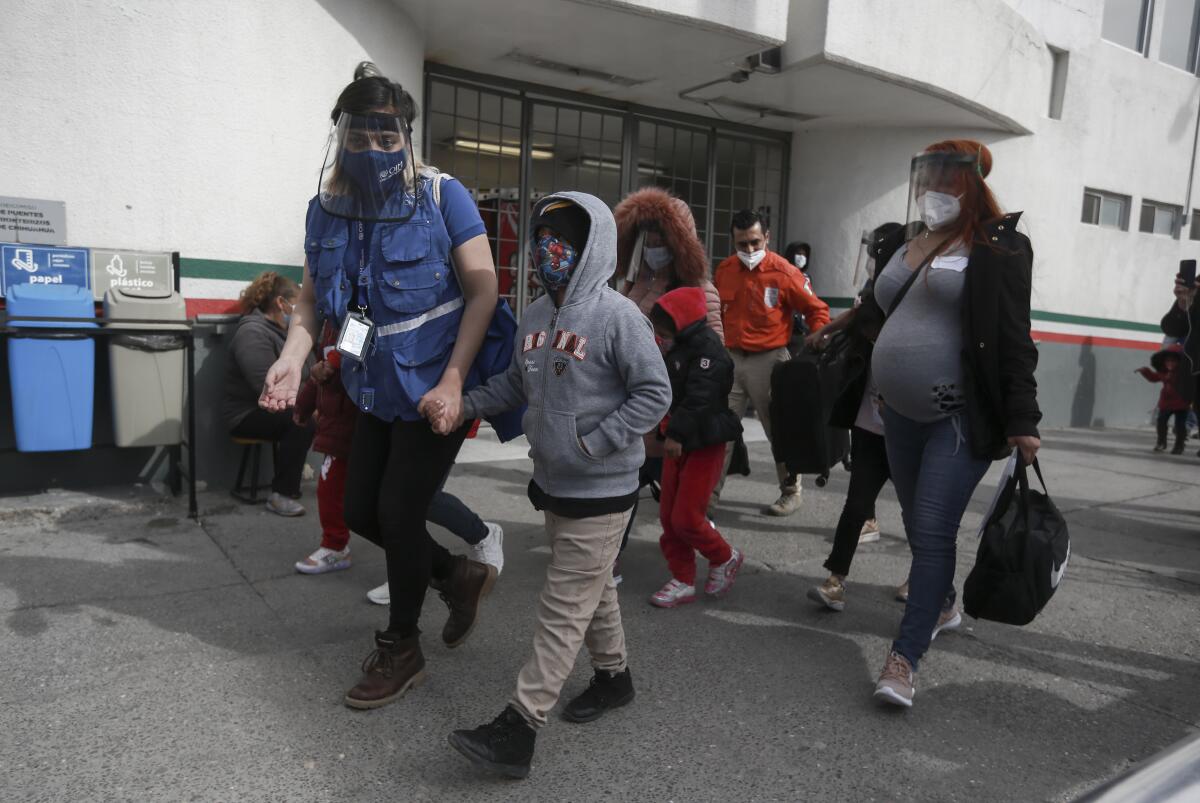Yes, there is a rise in child migration. But is there a ‘crisis’ at the southern border?

- Share via
Once again, the U.S. southern border is said to be in “crisis” after an increase in the number of children crossing clandestinely without their parents.
Last week, House Republicans pounced on the issue. On Monday, a GOP delegation traveled to the border city of El Paso, where they met with a scrum of reporters and described a U.S.-Mexico border in chaos.
“There is no other way to claim it than a Biden border crisis,” House Republican Leader Kevin McCarthy of Bakersfield said.
But is it a crisis?
Here’s what’s new.
In January and February, border authorities encountered more than 15,000 unaccompanied minors, an escalation of lone migrant kids coming to the border that began last year, according to the most recent statistics from U.S. Customs and Border Protection, but their numbers have gone up exponentially in recent weeks. According to the Associated Press, Border Patrol is holding more than 3,000 children in detention, a record high.
The rise in numbers of child migrants has stretched the ability to safely detain and shelter them, and there are reports of squalid and overcrowded conditions — which could be described as a humanitarian crisis.
Who are the unaccompanied minors?
Unaccompanied minors are children who come to the United States without a parent. Many — particularly those under 14 — are guided by a smuggler or a family member other than a parent, from whom officials generally separate the children, thereby categorizing them as unaccompanied. Rarely do children under the age of 14 make the journey on their own, experts say.
Are the numbers of unaccompanied minors hitting record highs?
At first glance, the numbers seem to be higher than a historic increase in 2019, when CBP reported 12,758 apprehensions of lone child migrants during the same time period.
But the data can be misleading and difficult to compare: The Department of Homeland Security classified the 2019 figures as “apprehensions,” while in 2021, they are described as “encounters.”
CBP defines apprehensions as “the physical control or temporary detainment of a person who is not lawfully in the U.S. which may or may not result in an arrest.” In 2019, apprehensions meant anyone who was taken into custody by border officials when they tried to cross the border illegally between ports of entry.
After March 2020, then-President Trump invoked Title 42, a rarely used 1944 public health authority that his administration claimed allowed border officials to quickly expel migrants seeking admission into the U.S., ostensibly to curb the spread of the coronavirus. Most migrants crossing the border without permission are simply “expelled” without much processing.
Since Title 42 was invoked, Border Patrol has labeled the data as encounters, not apprehensions. It’s problematic to compare them, because encounters can mean multiple attempted crossings by one person, artificially inflating the numbers. CBP estimates the rate of recidivism, or repeat crossings, at 40%.
We saw high numbers of unaccompanied minors in 2014 and 2019. Is this time different?
Violence and political instability are the primary factors driving the exodus, and that hasn’t changed significantly over the years. Much of the migration is from Guatemala, El Salvador and Honduras, exacerbated by recent hurricanes and the medical and financial fallout from COVID-19.
In 2014, an exodus of unaccompanied immigrant children from Central America took the Obama administration — including Vice President Joe Biden — by surprise. In response, the administration had to improvise and built a makeshift shelter, created with chain-link fencing, in a warehouse in Nogales, Ariz. Images from that facility regularly circulate on social media whenever critics invoke “kids in cages.”
Under law, unaccompanied migrant children who are not from a contiguous country require different handling than adults. In their attempts to handle an overwhelming situation, the government held children in border stations and detention centers as officials struggled to find a place for them to live while their cases made their way through immigration courts. In addition, the exodus led the Obama administration to resurrect and dramatically expand family detention, which studies show causes psychological harm to children.
In the past, many of these immigrants have surrendered to U.S. border officials and requested asylum, which is their legal right under U.S. and international law. But that changed under the Trump administration, which imposed a series of hard-line policies that made it nearly impossible to claim asylum in the U.S.
With asylum and other legal immigration avenues essentially blocked by the Trump administration, immigrants turned to smuggling organizations in higher numbers and tried to cross the border illegally.
In 2019, illegal immigration spiked, despite Trump’s strict immigration enforcement policies. In fiscal 2019, border officials apprehended 977,000 people at the southern border; an estimated 80,000 of them were unaccompanied minors.
“Even though the Trump administration put some pretty draconian policies into place, all its anti-immigration rhetoric — building a wall, family separation — that didn’t stop people from coming,” said David Lapan, who was spokesman for the Department of Homeland Security under Trump.
What is President Biden doing to address the increase in unaccompanied minors?
Most recently, the Biden administration directed the Federal Emergency Management Agency to support border officials in managing the arrival of unaccompanied children.
Theresa Cardinal Brown, managing director of immigration and cross-border policy at the Bipartisan Policy Center, called it a “prudent step” that shows Biden is taking the situation seriously.
“FEMA’s bread and butter is responding quickly to humanitarian and logistical challenges in response to natural disasters,” she said in a written statement. “These capabilities are exactly what is needed in this moment to effectively manage migration at the southern border.”
Biden has pledged to take a more humane approach than the one in 2014. His administration is scrambling to reopen a temporary influx facility for unaccompanied migrant children in Carrizo Springs, Texas, and others are being prepared to open soon.
But the political blowback is another matter. And the optics of what is being dubbed a “border crisis” could curtail his aspirations to pass some sort of comprehensive immigration reform this year that would provide a pathway to U.S. citizenship for more than 11 million people who are in the country without legal status.
Texas Gov. Greg Abbott and other Republican leaders are blaming Biden’s “open border policies.” Are we now an “open border” nation?
No. While there is a rise in illegal immigration, the U.S. remains closed to most foreigners due to Trump’s implementation of Title 42.
The Biden administration has so far kept the order in place except for children who cross the border without a parent. The administration is no longer expelling unaccompanied minors but is still quickly removing many children traveling with their parents.
The 15,000-plus unaccompanied children is an escalation but represents a small fraction of the nearly 180,000 overall encounters for the first two months of this year. And the 180,000 encounters for those two months is less than half the nearly 400,000 apprehensions along the southern border during the same period in fiscal year 2000. That year, border officials made 1.64 million apprehensions — an all-time high.
Molly O’Toole in Washington, D.C. contributed to this report.
More to Read
Sign up for Essential California
The most important California stories and recommendations in your inbox every morning.
You may occasionally receive promotional content from the Los Angeles Times.














